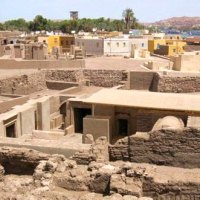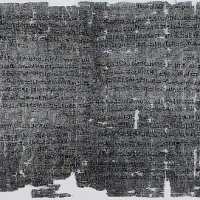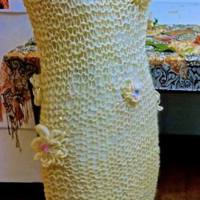[First posted May 2010, Revised 04 November 2011]
Qanat structures – underground water canals that can extend many miles – are a feature of the Middle East and North African agriculture that I find fascinating. It was Paul English who wrote one of the early, definitive studies on qanat technologies that peaked my interest many years ago; his work is still considered a classic today.
The technology is brilliant, in securing scarce water reserves, reducing evaporation of water in canal irrigation practiced in arid areas – as well as helping to protect the canal structures from use or destruction by others along the way.
So I was happy to find the following abstract on the topic, relating to qanats found in the oases of the Libyan (Western Desert) of Egypt. In fact, several decades ago when travelling in the oases of Kharagah and Bahariyah we came upon remnants of what, in hindsight, must have been qanat remains – since then, some have been more extensively renovated and were in use until modern pumping technology ‘took over’.
Qanat technology elsewhere:
Qanat technology was also taken to Valencia Spain during Islamic conquests and settlements in that area. There is an excellent work on the Spanish renditions of qanat technology and associated agriculture by Thomis Gleck entitled Irrigation and Society in Medieval Valencia and it is available on the web.
As well, there have recently been discovered in central and in the S.W. corner of Libya extensive foggara structures (read qanat) that were built and maintained for many years by the Garamantian tribal confederations between approximately 500 BC and 500 AD.
This is a fascinating technological development that appeared in response to the drying up of the Sahara in the late Holocene – the last phase of which took place 4500-5000 years ago. Vast water tables, however, allowed the continuation of farming through various technological means, as rains disappeared

Several qanat galleries as seen from above. Dush, in S. Khargah oasis. Source: Wuttmann, Qanats of 'Ayn-Manawar
Hence, I suspect the qanat technology in the Libyan Desert of Egypt that is discussed below, was introduced from further West in the Sahara – not from (or in addition to) further East in the Middle East, as the author (quoted below) states.
However, speculations are easy to make and we need more empirical studies (archaeological) of the kinds written about below.
“Qanat Landscapes” in the Oases of the Western Desert of Egypt: the Case of Bahariya Oasis Stefano Di Angelo. Dipartimento di Scienze del Mondo Antico, Università degli Studi della Tuscia, Viterbo, Italy
The qanat system is a technique born and developed in the Persian Empire in the Achaemenid Period, spreading rapidly in the basin of Middle and Near East and then in North Africa.
Only for Egypt we have stratigraphic data about the presence of qanat networks in the South Kharga Oasis used from the V century BC up to Roman time. But the presence of ancient qanat is attested also in the North Kharga Oasis and in the South Bahariya Oasis, related to settlements of Roman time.
Recently a qanat system was found near Qasr Allam, in the North Bahariya Oasis and during our investigations on the North-East of the oasis looking satellite imagery is outcropped an articulate qanat system related with ancient settlements, that was confirmed in recent partial surveys of this area.
In the Bahariya Oasis, like in Kharga and probably also in the other oases, the qanat system is therefore a distinctive aspect of the ancient landscape and an essential instrument to understand the human dynamic of this oasis in post-pharaonic time.
In an up-coming blog I will be talking about the Garamantians of southern Libya, whose agriculture was increasingly based on a complex foggara system (ca. 500BC – 500 AD) and who had trading and raiding links elsewhere in Africa and possibly in the western oases of Egypt.
Related articles
- Green Mint Tea and Beduin Carpets at Mersa Matruh, Egypt (dianabuja.wordpress.com)
- Elixir: A Human History of Water by Brian Fagan (telegraph.co.uk)






























Pingback: A Taste of 2012 – Top Posts Favor Colonial Era; Food; Ancient Egypt | DIANABUJA'S BLOG: Africa, the Middle East, Agriculture, History & Culture
Excellent information. Good history and background with helpful diagrams and photos.
LikeLike
Merci, Karen – so glad that you found the information useful and interesting!
LikeLike
i am the author of The WEstern Desert of Egypt: An Explorer’s Handbook where I discuss qanats in the various oases. I agree that they may have come from the west. I further suspect that the various forts, especially those at Kharga, specifically the fort at Ain Umm Dabadib, came from the west too. I would be interested in hearing what others have to say on this topic.
Cassandra
LikeLiked by 1 person
Hello Casandra and nice to meet you! I roamed abut the western desert during the years I lived and worked in Egypt and that was before all of the influx of tourists and so forth (thank goodness).
Glad to learn that you agree with the Western import hypothesis. I have to run, and will say more later today. You have a wonderful website, wish I could buy some of your books but not possible here in Burundi, where I live and work.
LikeLike